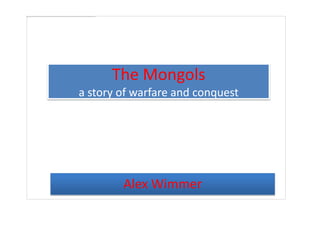
The mongols and warfare
- 1. The Mongols a story of warfare and conquest Alex Wimmer
- 2. A long time ago, in a distant land known as modern day Mongolia there lived a ambitious man. HIS NAME WAS GENGHIS KHAN
- 3. Genghis was an ambitious young man and wanted to be a great leader. Under his leadership, the Mongol tribes united to become a great nation.
- 4. Under Genghis’ leadership, the Mongols conquered many nations. It eventually became the largest empire in history,
- 5. The Empire stretched from China in the East. The Yaun Dynasty was founded by the Mongols in order to control China.
- 6. To the Middle East in the East. There they controlled the Black Sea and many Arabic trade routes.
- 7. Genghis’ army was able take over the other countries through his elite warriors. They were skilled horseman and archers and were able to travel quickly hundreds of miles.
- 8. The Mongol warrior’s main weapon was his horse. He was a skilled rider and his horse allowed him superior speed and agility.
- 9. The Mongol weapon of choice was the Composite Bow. The bow allowed increased range and all Mongol warriors were able to fire accurately while on horseback
- 10. When they had to fight hand to hand, the Mongols used sabers and spears that could be wielded on horseback.
- 11. The Mongols were known for their brutality on the battlefield. They became the most feared and hated warriors on the face of the planet.
- 12. The Mongols intimidated their opponents. They gave them the opportunity to surrender immediately and peaceful join the Mongol Empire. If their opponent refused then they would destroy their town and kill everyone.
- 13. The Mongol’s most famous and effective tactic was the Feigned Retreat. The Mongols would break ranks and pretend to run away. Their opponents would run after them and become disorganized. Meanwhile the Mongols would turn around and attack them while they were out of their ranks.
- 14. The Mongols also liked to use their superior mobility in their tactics. They would use their horses to flank and encircle their enemies and attack them from all sides.
- 15. The Mongols allowed their captured nations to keep their religion and customs. As the Empire grew, the Mongols spread and mixed the ideas and traditions of the conquered peoples. This created a creative atmosphere that supported trade.
- 16. Unfortunately, trade wasn’t the only thing the Mongols spread. A disease known as the “Black Death” was spread by the Mongols to the Middle East and Europe, where it killed over a third of the population.
- 17. It is said that the Mongols would throw cows and even people infected with disease into the cities in which they were trying to conquer.
- 18. The Mongols built their empire through war. They conquered through superior tactics and weapons. Their influence is still felt throughout the modern world.